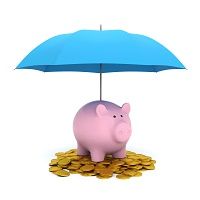A Few Options for Your 'Rainy Day' Fund
Even high-income individuals need a rainy day fund to ensure their financial progress isn't derailed by life's unexpected expenses. But where should you keep the money?

Investing—particularly for your retirement—is generally a long-term endeavor. Get in early, stay late, ride the course of market fluctuations, and chances are pretty good you’ll have a pretty healthy retirement nest egg.
But every portfolio also needs it share of liquidity. For dentists running their own practice or sharing one with partners, there is always the temptation to skip a contingency fund in favor of expanding your practice, buying new equipment, or hiring additional staff. While those are all legitimate uses of “extra” money, there is sound financial reasoning for establishing and maintaining an emergency fund. There are any number of circumstances for which you may need quick cash, including an expected home repair, the sudden illness of a family member, an unexpected interruption in your practice, or any number of life’s little curveballs.
Financial advisors and analysts recommend a “rainy day” fund for such eventualities, in part because it often turns out that funneling a portion of your investment income into a contingency fund has a positive overall impact on longer-term savings. Why? Because if a situation does arise, you can tap your contingency fund instead of siphoning off other investment income. But…where should you put it? Let’s go over a couple options.
Savings accounts. Your average savings account is not an investment vehicle, but it has many benefits, including the lack of fees, very high liquidity and safety, and the potential to earn at least a little bit of interest.
Money market accounts share some of the same qualities as a savings account, including safety and high liquidity, but with slightly less flexibility than savings accounts. There are typically limits on the number of checks you can write each month against a money market account, but this shouldn’t be a consideration if you’re using the account as a contingency vehicle.
Certificates of deposit (CDs) may not be the best choice for a rainy day fund, simply because of the fact that your investment will be more or less inaccessible until the CD reaches maturity—typically six months up to a year or longer. CDs are safe and stable, and they’ll typically pay a higher rate of return than a savings or money market account. But if you have to withdraw the money early, as sometimes happens when contingencies come up, you’ll pay a penalty that could wipe out most if not all of that return.
The important thing to remember for your contingency fund is that it doesn’t have to yield explosive growth or even have growth potential. What matters is that the investment is safe and relatively easy to get to on short notice. Having that money set aside frees up your other investments to take advantage of the inverse relationship between risk and reward, as well as the benefits of compound interest that build up over time.
ACTIVA BioACTIVE Bulk Flow Marks Pulpdent’s First Major Product Release in 4 Years
December 12th 2024Next-generation bulk-fill dental restorative raises the standard of care for bulk-fill procedures by providing natural remineralization support, while also overcoming current bulk-fill limitations.